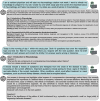Practical Applications of Large Language Models for Health Care Professionals and Scientists
- PMID: 39235317
- PMCID: PMC11391657
- DOI: 10.2196/58478
Practical Applications of Large Language Models for Health Care Professionals and Scientists
Abstract
With the popularization of large language models (LLMs), strategies for their effective and safe usage in health care and research have become increasingly pertinent. Despite the growing interest and eagerness among health care professionals and scientists to exploit the potential of LLMs, initial attempts may yield suboptimal results due to a lack of user experience, thus complicating the integration of artificial intelligence (AI) tools into workplace routine. Focusing on scientists and health care professionals with limited LLM experience, this viewpoint article highlights and discusses 6 easy-to-implement use cases of practical relevance. These encompass customizing translations, refining text and extracting information, generating comprehensive overviews and specialized insights, compiling ideas into cohesive narratives, crafting personalized educational materials, and facilitating intellectual sparring. Additionally, we discuss general prompting strategies and precautions for the implementation of AI tools in biomedicine. Despite various hurdles and challenges, the integration of LLMs into daily routines of physicians and researchers promises heightened workplace productivity and efficiency.
Keywords: AI; LLM; applications; artificial intelligence; chatGPT; health care; healthcare; large language model; physicians; prompting; scientists.
© Florian Reis, Christian Lenz, Manfred Gossen, Hans-Dieter Volk, Norman Michael Drzeniek. Originally published in JMIR Medical Informatics (https://medinform.jmir.org).
Conflict of interest statement
Figures




References
-
- Rate of adoption for major internet and technology services in 2022. Statista. [15-01-2024]. https://www.statista.com/statistics/1360613/adoption-rate-of-major-iot-t... URL. Accessed.
-
- Frieder S, Pinchetti L, Chevalier A, et al. Mathematical capabilities of ChatGPT. arXiv. 2023 Jan 31; doi: 10.48550/arXiv.2301.13867. Preprint posted online on. doi. - DOI
LinkOut - more resources
Full Text Sources

